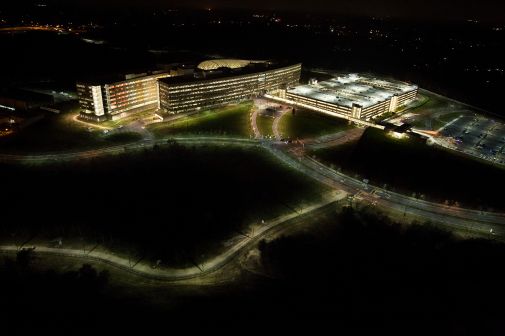Geospatial intelligence in the age of Cardillo
Robert Cardillo made a daring prediction Wednesday night: The skies will soon darken, he said, and usher in the golden age of democratized geospatial intelligence.
“The skies — really space — will darken with hundreds of small [satellites] to be launched by Skybox, Planet Labs, BlackSky and others,” Cardillo, director of the National Geospatial-Intelligence Agency, said at a dinner sponsored by the Intelligence and National Security Alliance. It is part of a technological “future in which everything and everyone is interconnected and geospatial data is democratized and available to everyone,” he said.
Cardillo, the former deputy director for intelligence integration at the Office of the Director of National Intelligence who took the helm of NGA late last year, outlined an aggressive agenda to make NGA a leader in the larger effort to improve collaboration and integration across the 17 agencies that make up the intelligence community. But NGA may already occupy that leading position, logging an impressive number of innovations in the fields of data visualization and open source app development.
NGA took a leading role in the U.S. response to the Ebola crisis in West Africa, becoming the first intelligence agency to create a website with relevant unclassified content.
“It is open to everyone — no passwords, no closed groups,” Cardillo said.
Since NGA launched the site last October, the agency has posted 224 geospatial products and has increased the number of layers of feature data available online from 12 to 358. At least 135 more layers are in the final stage before posting, Cardillo said.
The agency also detailed a geospatial intelligence analyst to the Army’s 101st Airborne Division in Liberia to help upgrade the country’s out-of-date maps. The analyst uses commercial imagery and collaborates with Liberian analysts who work for their equivalent of the NGA – the Liberian Institute of Statistics-Geo-Information Services.
NGA also counts itself as the first intelligence agency to crowdsource applications development. “Through the GitHub open sourcing and crowdsourcing platform, we have invited the public to help us improve our disaster response applications on 16 different topics,” Cardillo said.
The agency recently collaborated with Digital Globe to release its 16th app on GitHub called MrGEO — MapReduce GEO.
“It is a toolkit that leverages the power of cloud-based architecture to solve geospatial problems,” Cardillo said. “First responders can use MrGEO to plan the best ways in and out of dangerous areas by taking into account terrain, land use and weather.”
In another first for the intelligence community, NGA published a free safety of navigation app on iTunes and Google Play called Anti-Shipping Activity Messages, or ASAM. The ASAM mobile app includes the geographic location and reported accounts of piracy, robbery, hijacking and kidnapping targeting maritime ships, crews and passengers.

One of the many geospatial products made available to the public by NGA to support the Ebola crisis response effort. (NGA)
These accomplishments and the road ahead for NGA are tied closely to what Cardillo referred to as “the rapidly spreading geography of the Internet.” It is this merger of technology and the venerable skill of reading a map that informs one of Cardillo’s central tenets: “Everything, everyplace, everyone exists in a time and a place.”
Valid questions
For now, the democratization of geospatial intelligence raises more questions than it answers.
“The questions that arise from the persistence of geospatial data streaming from hundreds of satellites covering the Earth multiple times a day are staggering,” Cardillo said. “The challenges of taking advantage of that data are daunting.”
The amount of data that will be generated by the future network of imaging satellites makes storing that data locally an unrealistic option. “So will we have to go to an imagery as a service model and buy only what we need when we need it? This change will be less about the images and more about the derived information or analytics,” Cardillo said.
And these are only the beginning of the questions that must be answered about the impact of what Cardillo referred to as “the small sat revolution.”
“What questions can we answer with daily coverage of the planet? What choices will our adversaries make with daily coverage of the planet? How will we maintain decision advantage in such a playing field?” he asked.
“That opportunity is to look at GEOINT through a new lens — the lens of consequence.”






